How to Make your Brand Stand Out
Being a newbie in any industry is tough, most especially in the cutthroat world of food and bever-ag...
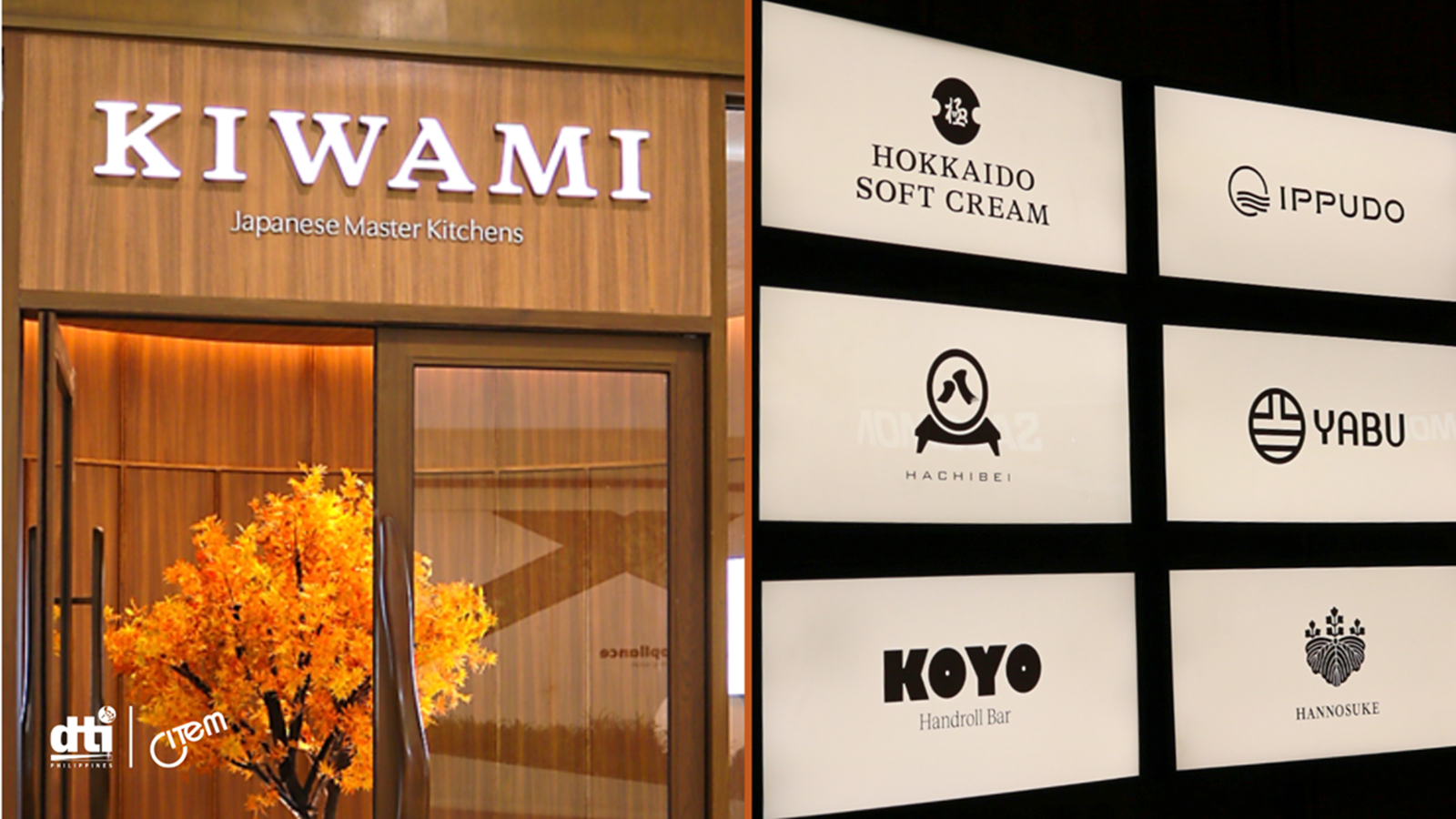
August 08, 2025
We explored a single-dish mastery concept in the Metro that is helping shape food culture in the country by slowly transforming global food to suit local sensibilities.
Food is a walking dichotomy. Basic yet scarce, universal yet diverse, essential yet expensive, flavorful yet unappealing and vice versa–the list goes on, and sometimes, more divisive than others. Yet, with the success of Kiwami Japanese Master Kitchens comes growing proof that food can be global yet local, refined yet affordable, and authentic yet inclusive.
Opened in the country in 2021, it continues to tap into the evolving Filipino palate, one that is shaped by the penchant of Filipinos to adapt to new cultures and tastes.
Instant access to media and relative ease of overseas travel have contributed a more informed appreciation for international fare. Almost seven million Filipinos traveled outside the country in 2024 alone, 60% of which was made to neighboring Hong Kong, Japan, and Singapore.
What was once considered an exception now seems to be the norm when it comes to the taste preference of Filipinos for international fare, in particular, for Japanese cuisine. So much so, that opening week brought P1M in net sales for the Mall of Asia branch.
According to Kiwami Brand Technical Head Chef Dexter Supena, such milestones speak of their customer loyalty and love for the brand. As an industry veteran, he has seen how consumers have generally matured. “I think Filipino food lovers don’t really look at cuisine or a type of food. They now go for bold flavors instead. When you look at social media, they highlight what they like about the dish, not necessarily because it’s Japanese or some other cuisine. What do I like? What brings me comfort is how we go about our food choices.”
 Any time is a good time for Japanese. Early weekday lunch crowd at Kiwami MOA.
Any time is a good time for Japanese. Early weekday lunch crowd at Kiwami MOA.
And with comfort comes convenience. Diners need not go out of the country, nor go to separate locations. Its contemporary take on Japanese cuisine involves bringing together several restaurant brands in one convenient space. Each managed kitchen focuses on a single dish mastery – the katsu from Yabu, ramen from Ippudo, yakitori from Hachibei, tempura from Hannosuke, and the latest additions - handrolled sushi from Koyo, and soft ice cream from Hokkaido Soft Cream. Adding to the convenience is having to mind only a single bill while enjoying choice dishes from different kitchens at the comfort of your table.
As important as taste and flavor, Chef Dexter Supena explained that when creating a menu or item, the number one thing they really think about is the value of a dish, rather than focusing on merely putting something out and making it look expensive. Tapping into Filipino values, the team behind Kiwami made sure to celebrate the ability to make real connections through a sense of community and generosity. Such are evident in the intentional sharing aspect of their fresh platters at Koyo, and Hibachi large plates composed of different grilled meats and seafood served by Hachibei.
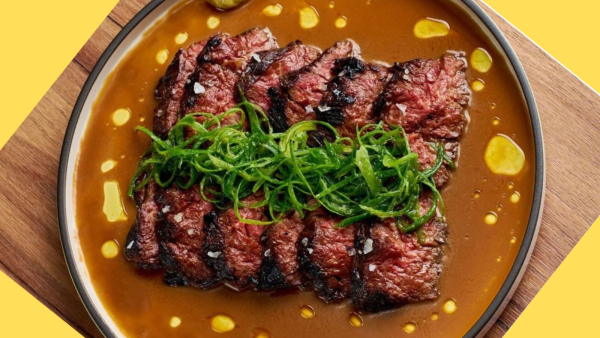 Diners enjoy sharing the love with the Hibachi Hanger Steak plate. Japanese cooking technique brings the prized butcher’s cut to a memorable beef dish. Using secret sauces and grilled to perfection with binchotan charcoal, all the Australian beef for this dish are guaranteed Halal and USD-approved prime cuts, according to Chef Rinion. Since its launch, about 70-80 plates are ordered daily. Photo: @kiwam.ph
Diners enjoy sharing the love with the Hibachi Hanger Steak plate. Japanese cooking technique brings the prized butcher’s cut to a memorable beef dish. Using secret sauces and grilled to perfection with binchotan charcoal, all the Australian beef for this dish are guaranteed Halal and USD-approved prime cuts, according to Chef Rinion. Since its launch, about 70-80 plates are ordered daily. Photo: @kiwam.ph
Competitive pricing is another factor holding weight with Filipino consumers. Paired with unmatched food quality, prices are surprisingly fair for the food and experience they create at the restaurant. Kiwami Technical Manager Chef Joseph Benj Rinion shared, “There will always be competitors and other brands around us, but we’ve seen growth since we opened in June. Most people would think it’s expensive here at Kiwami, but once they step in and open the menu and then try the quality of the food, everything changes. This loyalty, he believes, is fueled by their appreciation of the difference in the food.”
And just maybe, the real mastery we have seen in Kiwami is a quiet ability to localize its Japanese menu without compromising authenticity. Being particularly hands-on with Hachibei, Chef Rinion takes pride in adhering to their Japanese principles, making sure that the same quality standards and taste of the Hakata-style yakitori are present in the offerings all their chefs make in-house.
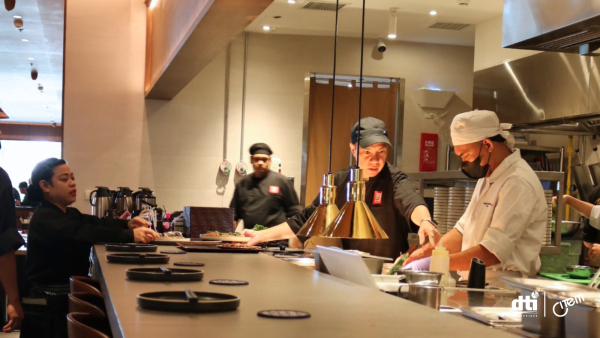 Mastery at work, Chef Joseph Rinion (at center) with one hand serving a plate and the other directing at the Habichei Kitchen counter.
Mastery at work, Chef Joseph Rinion (at center) with one hand serving a plate and the other directing at the Habichei Kitchen counter.
Discussing what makes Filipinos appreciate Hibachi, Chef Rinion points to how they adapted yakitori for more Filipinos and diners in general. He explains, “Yakitori is a staple of Japanese food and goes way back in its deep culture and history. It’s similar to what inihaw is to Filipino cooking.” He says that choosing to go with the Hakata style yakitori was to bring inclusivity. Instead of just the traditional chicken, people get to enjoy variety in their grilled dishes, such as pork, seafood, and vegetables.
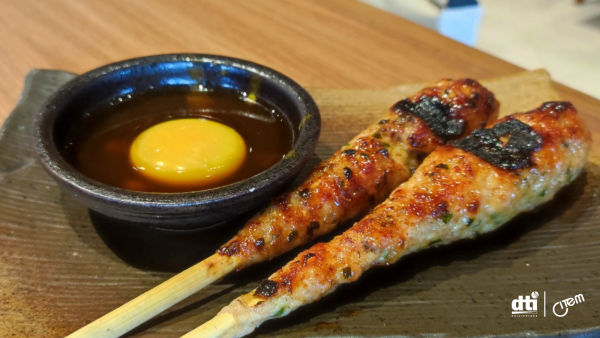 Classic yakitori featuring chicken meat packed with flavor and served with raw egg as dipping sauce for a creamier flavor and texture.
Classic yakitori featuring chicken meat packed with flavor and served with raw egg as dipping sauce for a creamier flavor and texture.
The conscious considerations for incorporating local taste into Kiwami’s offerings extend to all its housed concepts. In Hannosuke, tempura selections include chicken and egg treated in the same skilled preparation as they would typical seafood and vegetable varieties.
The strong appetite of Filipinos for seafood was a key reason why Koyo was created for their sushi brand. According to Chef Dexter, “When we opened, we felt something was lacking, and so did our guests. We thought about sushi, how it’s a well-known Japanese cuisine that is a hit with Japanese food lovers here or anywhere else, actually.”
 Bursting with a surprising harmony of distinct sweet, salty, and citrus flavors is the Salmon Soy Ginger always made and served fresh.
Bursting with a surprising harmony of distinct sweet, salty, and citrus flavors is the Salmon Soy Ginger always made and served fresh.
The presence of Kiwami and similar establishments offering international cuisine opens significant potential for expanding the growth of local food sourcing. And such an idea is not lost on the Filipino chefs at the helm of Kiwami’s Master Kitchens. Chef Kenneth Sadiasa, who works his magic with the sushi creations, shared that in Koyo alone, “we consume about 50kgs of salmon a week, that’s why we order supplies twice a week.”
Not all mains can be replaced by local ingredients. However, gaining a viable commitment to introduce locally produced food and ingredients is not far-fetched. In the Philippines, tuna is a premium 7 export product along with banana, cacao, coconut, coffee, mango, and pineapple. Apart from tuna, the country is also a major exporter of shrimp, and other premium quality seafood that includes about 80% of global carrageenan from seaweed. And with Filipino chefs at the helm of international cuisine establishments, whether in fine dining or casual settings, they are already in an ideal position to push the envelope.
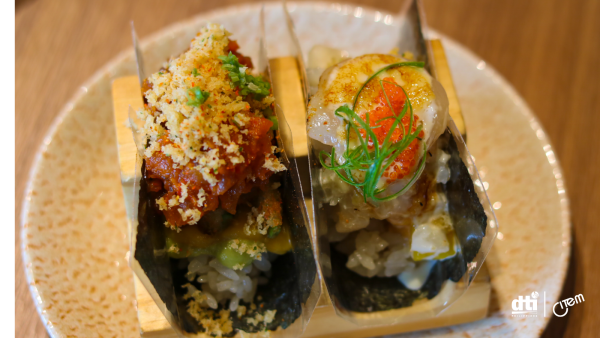 A simple yet innovative practice at Koyo is the use of plastic wrapping for the fresh nori sheets used in handrolls. Not only does this prevent getting soggy servings, but it also adds to the visual experience of each carefully crafted dish.
A simple yet innovative practice at Koyo is the use of plastic wrapping for the fresh nori sheets used in handrolls. Not only does this prevent getting soggy servings, but it also adds to the visual experience of each carefully crafted dish.
Koyo, which specializes in hand-rolled sushi and offers sashimi and other fresh raw seafood dishes, already boasts a creative menu with elements familiar to Filipino taste. This includes a snapper handroll with toasted coconuts, crispy salmon skin as garnish reminiscent of the classic chicharon, and a salmon sashimi infused with distinct ginger and orange juices for that Filipino love for citrus flavors.
The growing demand for international fare in the local food scene speaks of the evolving taste of Filipinos when it comes to cuisine, reshaping people’s relationship with food–how, what, and when food is accessed, prepared, and consumed.
Kiwami Japanese Master Kitchens is operated by the Filipino-owned Standard Hospitality Group. It recently opened its third, and biggest to date, location at the Mall of Asia in Pasay City.
Explore more stories on Filipino food and culture here at IFEXConnect and stay updated with the latest through our socials.
Check out these food fusions between Filipino and Middle Eastern cuisines
The unending quest for healthy and sustainable food amid changing lifestyles
A quick look at the Philippine food staple often getting a bad health rap